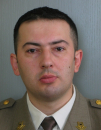HrvatskihrEnglishen

Command and Control
Command and Control
Data is displayed for the academic year: 2025./2026.
Lecturers
Exercises
Lectures
Course Description
Acquisition of basic knowledge and skills that can be used in command as a philosophy of commanding and combat function in current national and multinational operations. By studying the subject cadets will widen their understanding of the mission command structure, its principles and the role of the commander who applies it in manoeuvre approach to operations. During the course, the language of mission commanding is used and the way of its application in planning, directing, coordinating and controlling of the forces and operations during the operations is discussed. Students will develop specific competencies in exercise sessions and their individual work, according to their abilities.
Study Programmes
graduate
Military Leadership and Management - study
(2. semester)
Learning Outcomes
- Compare the authority of the commander and NATO command relations
- Distinguish between commanding as a combat function and command philosophy
- Compare the command concepts (mission command and detailed command)
- Explain the principles of command
- Explain the role of the commander in the operational process (understanding, visualization, description, guiding and assessment of the operation)
- Compare the relation between command and implementation of control
- Explain and apply knowledge management and information management
- Explain the role of the staff and the organization of the command post at a company/battalion level
- Explain the role of CIMIC in operations
- Explain the role of religious support in operations
Forms of Teaching
Lectures
Lectures are performed in classroom using power point presentations and videos in support of the teaching material.
ExercisesAfter each lecture, exercises are conducted to better identify theoretical material using specific scenarios, videos, graphics and maps.
Week by Week Schedule
- Introduction to Command and Control, 2 hours (Introductory lecture, 1 hour): Getting acquainted with the course, the course teacher and instructors; getting acquainted with the dynamics and lecture content, terms and obligations of the attendees as well as with the evaluation and grading systems. Nature of Command and Control 1 (Operational areas, combat functions and combat power, use of combat power through the implementation of NATO tactical activities, definition of command at tactical and joint levels, relationship between the command and control)
- The Effect of the Environment on Command Implementation, 2 hours (people, lack of safety, time and space, ground force operations, logistics, information, technology)
- Command Concepts, 2 hours (mission command and detailed command)
- Elements of Command, 2 hours (authority and NATO Command Relationships, decision making, art of command, leadership and control)
- Principles of Command, 2 hours (development of cohesive teams through mutual trust, establishing mutual understanding, issuing a clear commander’s intent, implementation of mission command and acceptance of reasonable risks)
- Commander and Operational Process, 2 hours (understanding the environment and defining the problem – operational variables and mission variables
- Preliminary exam 1
- Commander and Operational Process, 2 hours (operation visualization – operational approach to the operation)
- Commander and Operational Process, 2 hours (describing and guiding the operation – defined problem, commander’s guidelines, commander’s intent, commander’s requirements for critical information)
- Commanding During the Operation, 2 hours (position and presence of the commander, command organization and control methods)
- Commander’s role in Command Execution, 2 hours (creation of positive command climate, training of subordinates in command and control)
- Command in the Croatian Armed Forces, 2 hours (structure of the CAF, levels of authority and command organization in operations at strategic, operational and tactical levels, command powers in the armed forces)
- Command Support, 2 hours (role, deployment and design of command support)
- Command posts, 2 hours (organization and types of command posts at company/battalion levels
- Preliminary exam 2
Literature
Dimitriev, Fabijančić (2019.), Zapovijedanje, MORH
(.), Interni nastavni materijali dostupni na sustavu e-učenja, GS OS RH
For students
General
ID 282365
Summer semester
5.0 ECTS
L0 English Level
L1 e-Learning
30 Lectures
30 Exercises


